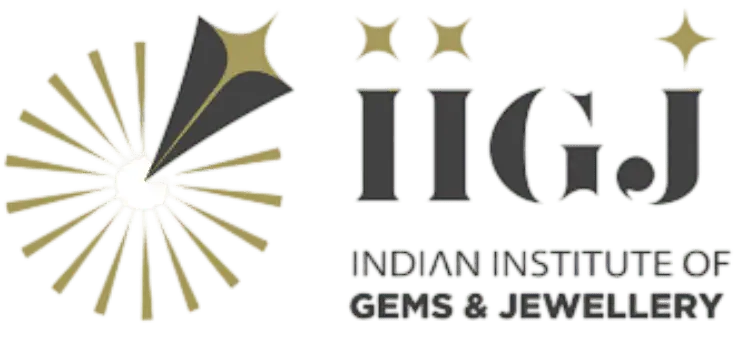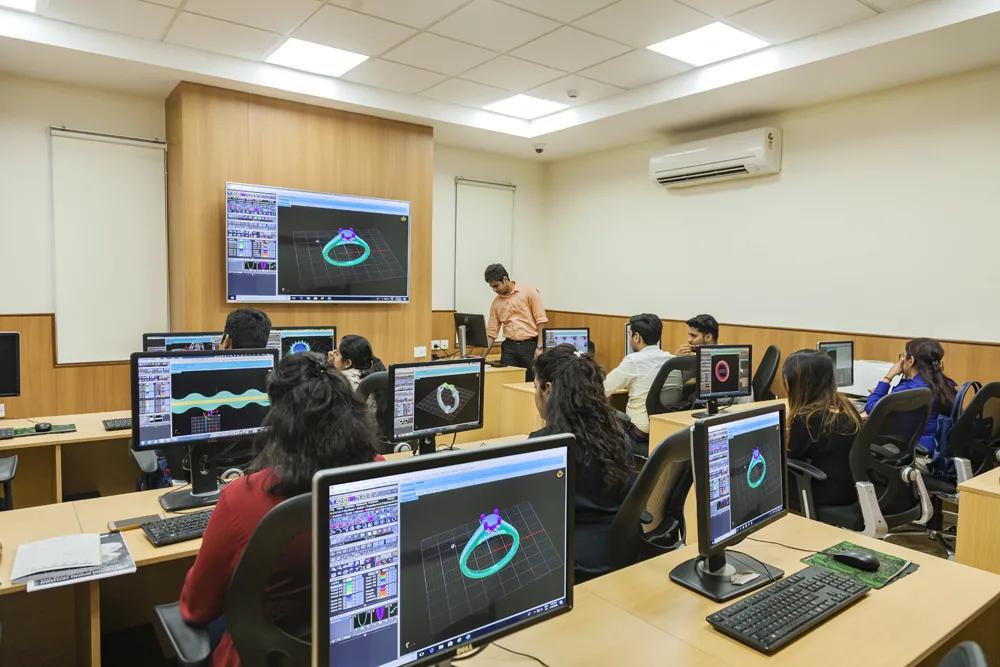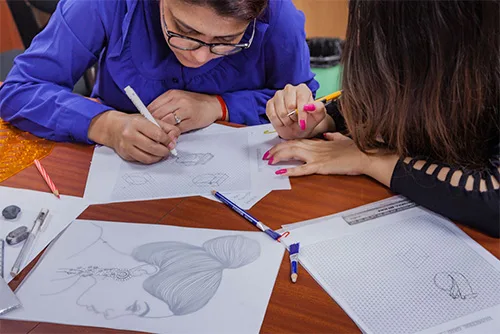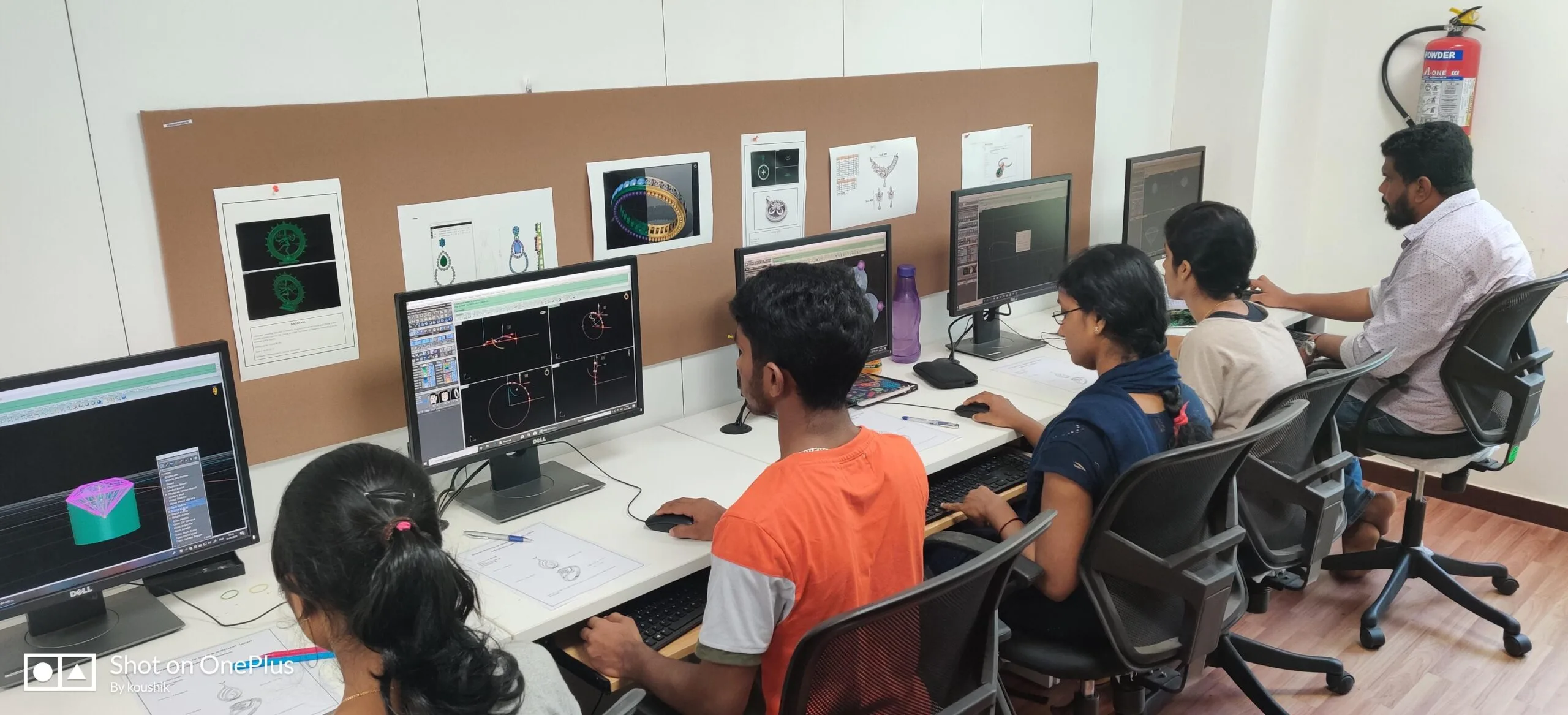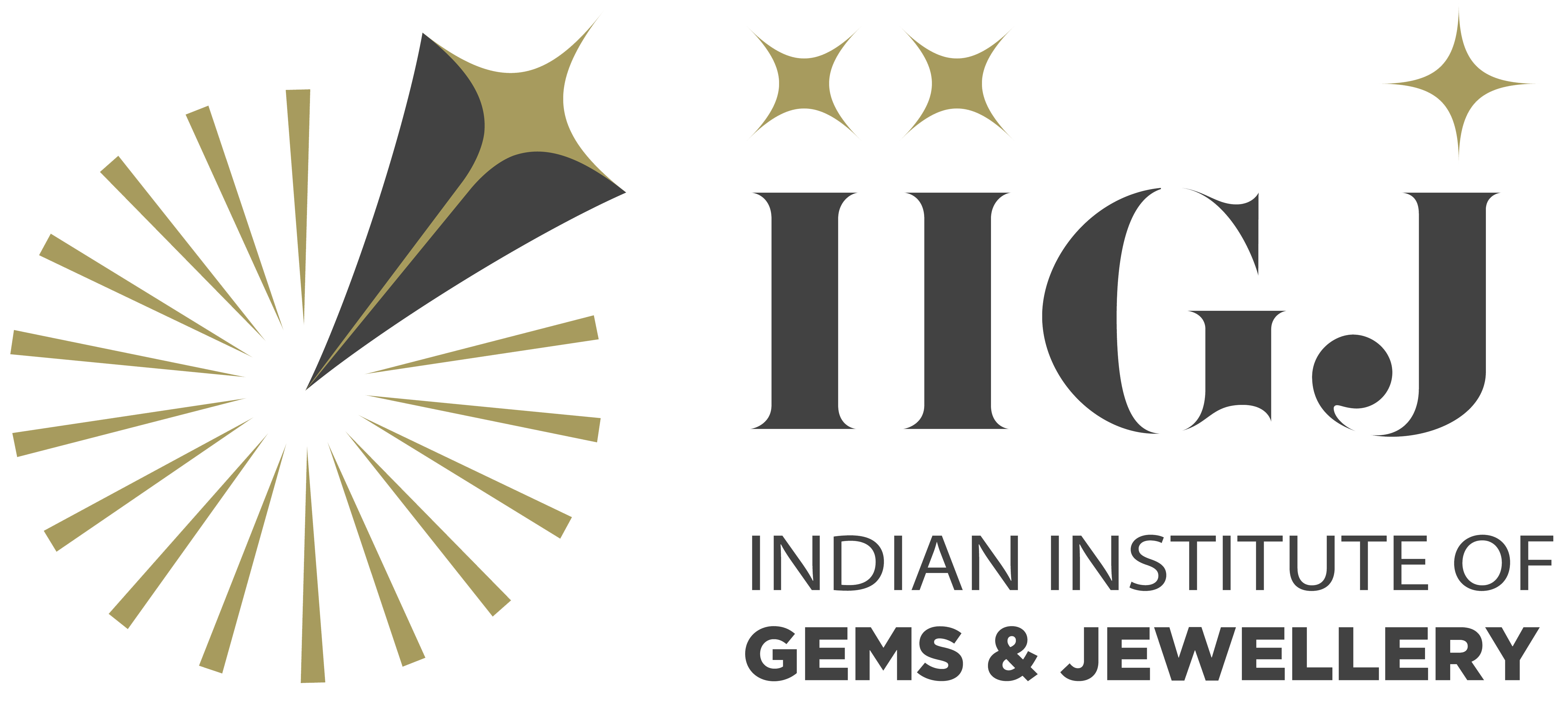IIGJ Delhi Participates in State-Level Career Conclave
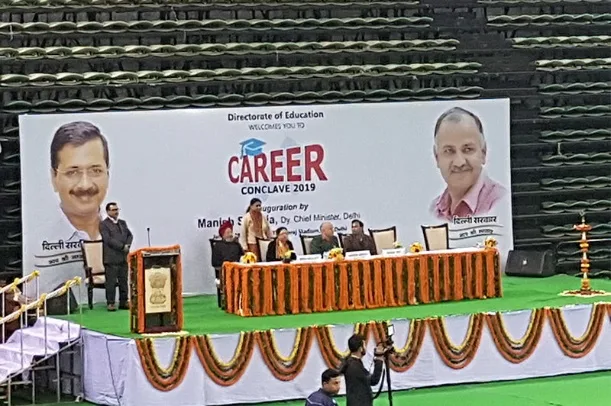
28.1.2022, New Delhi: “Career Conclave” was organized by the Delhi Directorate of Education (DoE) from Monday, 28th Jan 2022. The four-day conclave provided a platform to a number of public & private educational institutions, universities (both govt. & semi govt.) along with para military forces. The Career Conclave was Inaugurated by Mr. Manish Sisodia, Deputy CM, Delhi. IIGJ Delhi participated to provide career guidance and showcase career opportunities to Class 12 students at the Conclave.
GJEPC Welcomes new Chairman of the IIGJ MUMBAI Board, Mr. Vasant Mehta

Mr. Vasant Mehta, former Chairman of Gem & Jewellery Export Promotion Council and founder Director and former Chairman of Indian Institute of Gems & Jewellery, Mumbai is elected as Chairman of the Board of IIGJ Mumbai. He has taken charge from Mr. Kirit Bhansali, who served as Chairman from 2016 to 2022. The ceremony at IIGJ, was attended by Mr. Vipul Shah and Mr. Kirit Bhansali to formally welcome the new chairman of IGJ Mumbai. Mr. Mehta addressed IIGJ Mumbai staff, praising the leadership provided by Mr. Bhansali during his tenure and GJEPC’s role in the growth of IIGJ, said “I am happy for the opportunity to serve IIGJ as Chairman of the Board once again. IIGJ has come a long way since it began in 2006 and it will be my continuous endeavour to take the Institute to new heights for it to become a benchmark in gem & jewellery education.” Mr. Mehta is passionate about gem & jewellery education and creating trained professionals for the fast-growing industry, which was GJEPC’s main objective behind creating IIGJ. Mr. Mehta served as GJEPC Chairman from 2008-10, and has brought about immense transformation in the Indian diamond manufacturing industry as a global jewellery manufacturing hub, with a focus on quality and design oriented jewellery. He has also served as Chairman of IIGJ Mumbai (2009 to 2016), Director of the National Skill Development Corporation (NSDC), and Vice President of International Diamond Manufacturers Association (IDMA). He works untiringly to safeguard the interests of diamond manufacturers and spread the message of best practices in the trade. Mr. Mehta is a second-generation diamantaire, and founder-senior partner of M/s. V. Rameshchandra & Co. He has been serving his family business for over 50 years. The GJEPC Chairman Mr. Vipul Shah while addressing the attendees assured of his complete support to Mr. Mehta and IIGJ in their continuous efforts to achieve the set vision of the institute.
IIGJ Mumbai’s Convocation Ceremony for Post Graduate Diploma in Jewellery Management Graduates held on 4th March 2023

Winner Best Student Batch -September 2020 Shraddha Khanted Winner Best Student Batch – March2021Shayori Mandal Winner Best Student Batch -September 2021 Roshan Verma The Indian Institute of Gems & Jewellery, Mumbai held its convocation ceremony for graduates of the 1-year Post Graduate Diploma in Jewellery Management programme today at the Institute’ auditorium, in which graduates of three batches were conferred with diplomas. Dr. Saumya Badgayan, Vice President-HR & IR graced the occasion as Chief Guest and presented trophies and certificates to the graduates. Ms. Dolly Choudhary, Director, Marketing & Promotions, GJEPC, was Guest of Honour. Chairman of IIGJ Mumbai, Mr. Milan Chokshi and Ms. Nirupa Bhatt, Advisor, Gem & Jewellery industry were also present along with Mr. Bharat Vaswani , Head of Institute, IIGJ Mumbai. Apart from inviting the students of the 2021 batches, the Institute went the extra mile and invited students of the September 2020 batch as well, as they had not had a physical convocation ceremony last year due to the pandemic. Chief Guest: Dr. Saumya Badgayan, Vice President-HR & IR Guest of Honour: Ms. Dolly Choudhary, Director, Marketing & Promotions, Gem & Jewellery Export Promotion Council. All the students of the PG Diploma in Jewellery Management are now either employed with prestigious jewellery companies or working on their own jewellery collections as entrepreneurs or have been absorbed into their family businesses. Chief Guest, Dr. Saumya Badgayan felicitated the students and advised the students, saying, “The industry is undergoing a metamorphosis…The industry needs people like you, who are not in the business of design… or production…or merchandising, but in the business of emotions…Don’t do things for competitive reasons…don’t take your career as a luxury. Be ready for the rigour it will throw back at you…stay focused on your trajectory…” Speaking at the ceremony, Mr. Bharat Vaswani, Head of Institute said, “Be the IIGJ Brand ambassadors of the impact we create as you join the 10,000 plus alumni from this great Institution.” Other distinguished guests also encouraged the graduating students and provided words of wisdom and guidance during the ceremony
IIGJ Connects with South India’s Jewellery Industry for the First Time at IIJS Tritiya 2023

Indian Institute of Gems & Jewellery was proud to showcase jewellery creations of its design graduates at IIJS Tritiya 2023, for the very first time in South India. Both the Academics and Laboratories wings were present at the 4- day exhibition, eagerly meeting with participants as well as visitors and sharing information about the huge potential of trained jewellery professionals and state-of-the-art lab testing of gems & jewellery. Commenting on the exhibition, Head of the Institute, Mumbai, Mr. Bharat Vaswani said “The response from visitors to our stall was extremely positive and encouraging. Several jewellery companies expressed their interest in collaborating with IIGJ for their intern and recruitment needs, especially after seeing the quality of the jewellery on exhibit and understanding about the curriculums of various programmes and courses offered by IIGJ. Although students from the southern states have taken various programmes at IIGJ over the years, we are looking forward to sharing our expertise with the regional gem and jewellery industry in both areas – Academics as well as Laboratories.” Two installations with IIGJ students’ work brought a fresh new design appeal to the IIGJ stall and were appreciated by visitors to the stall.
ORRA collaborates with IIGJ Mumbai for Retail Trainee Scheme
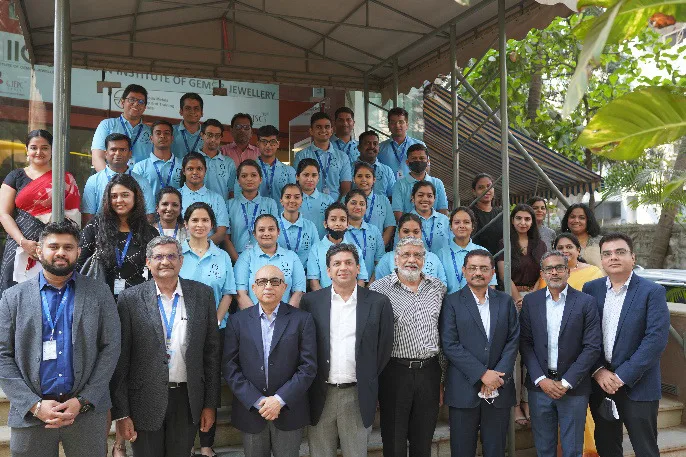
6.3.2021, Mumbai: ORRA Fine Jewellery collaborated with IIGJ Mumbai to deliver its Graduate Retail Trainee Programme.The intensive, 2-week programme from 22nd February to 6th March 2021 was conducted by IIGJ faculty of design, gemmology and manufacturing departments and ORRA sales team members at the Institute. The first batch of 24 students from various locations were trained, certified and placed in various stores of ORRA.
Revolutionising Gems & Jewellery Education: A Closer Look at IIGJ Mumbai

IIGJ Mumbai graduates celebrating Indian Institute of Gems & Jewellery (IIGJ) Mumbai stands as a centre of excellence in the gems and jewellery industry, providing comprehensive education and training to aspiring professionals. Established in 2003 under the auspices of the Gem & Jewellery Export Promotion Council (GJEPC), IIGJ Mumbai has continually strived to meet the evolving needs of the industry and produce skilled individuals who contribute to its growth. With its state-of-the-art infrastructure, industry-oriented curriculum, and collaborations with leading stakeholders, IIGJ Mumbai has earned a reputation as a premier institution that equips students with the knowledge, skills, and practical experience necessary to thrive in the competitive world of gems and jewellery, Bharat Vaswani, Head of the Institute, tells Solitaire. Please provide an overview of the IIGJ Mumbai and its role in the industry? Indian Institute of Gems & Jewellery (IIGJ) is an initiative of the Gem & Jewellery Export Promotion Council (GJEPC). The Mumbai centre was setup in 2003 and is located in MIDC, near SEEPZ. The institute was created with a vision to provide comprehensive education and training in jewellery design, gemmology, manufacturing, and merchandising. Over the years, IIGJ Mumbai has earned a reputation for its exceptional teaching, state-of-the-art infrastructure and industry-oriented curriculum. The IIGJ Mumbai campus is a testament to the institute’s commitment to providing students with an environment conducive to learning. Equipped with modern CAD laboratories, gemstone library, design studios and manufacturing workshop, students have access to cutting-edge facilities that foster practical learning. These resources allow students to gain hands-on experience in gemstone identification, jewellery manufacturing techniques and the latest design trends. IIGJ Mumbai offers many different courses tailored to meet the demands of the ever-evolving gem and jewellery industry. With an option to choose from short-term certificate courses and comprehensive undergraduate and postgraduate programmes, students have the opportunity to choose a path that is aligned with their interests and career aspirations. The curriculum blends theoretical knowledge with practical training, ensuring that students are well-equipped to enter the industry with confidence. Recognising the importance of industry exposure, IIGJ Mumbai has forged strong ties with leading jewellery houses, gemstone dealers, and manufacturers. The institute regularly organises workshops, seminars and guest lectures by industry experts, enabling students to gain insights into the latest trends, technologies, and market dynamics. Furthermore, IIGJ Mumbai facilitates internships and placements, providing students with invaluable real-world experience, thereby enhancing their employability. With access to modern design software and guidance from experienced faculty, students are empowered to create innovative and exquisite jewellery pieces that reflect their artistic vision and have been consistently well-received by the industry. IIGJ Mumbai focuses on cultivating an entrepreneurial mindset among its students. The institute offers courses and workshops on jewellery entrepreneurship, providing students with the knowledge and skills required to start their own jewellery businesses. With its unwavering commitment to quality education and industry-oriented training, IIGJ Mumbai has played a vital role in shaping the future of the jewellery industry in the past and will continue to do so in future. Two-finger ring by Vaishnavi Divate Earrings by Dev Mudgal What are some of the key initiatives taken by IIGJ Mumbai to produce trained professionals in the gems and jewellery sector? The gems & jewellery sector is a significant contributor to India’s economy, renowned for its rich heritage and craftsmanship. By providing comprehensive education and training programmes, IIGJ Mumbai is empowering individuals to excel in this thriving industry. In order to meet the industry’s growing demands for skilled professionals, the IIGJ Mumbai has undertaken several key initiatives, few of which are: Robust Curriculum and Course Offerings: IIGJ Mumbai has developed a comprehensive and industry-oriented curriculum to equip students with the necessary knowledge and skills. The curriculum is regularly updated to stay aligned with the latest trends, techniques, and technologies used in the industry, ensuring that students receive relevant and up-to-date education. State-of-the-Art Infrastructure and Learning Environment: IIGJ Mumbai provides an environment that is conducive to learning, with modern facilities and infrastructure. The institute has well-equipped classrooms, advanced gemmological laboratories and gemstone identification centre, design studios, computer-aided design (CAD) labs and a manufacturing workshop. This enables students to gain hands-on experience with industry-standard tools, machinery and software thereby enhancing their practical skills and understanding. Industry-Expert Faculty: IIGJ Mumbai boasts of a teaching team of experienced and highly skilled faculty members who are industry experts as well. These faculty members bring in-depth knowledge, industry insights and real-world experience to the classroom, enriching the students’ learning experience. The faculty’s expertise helps bridge the gap between theoretical concepts and practical applications, preparing students for the challenges of the industry. Immersive Industry (Factory/Retail Setups) Visits: The students are exposed to real-life jewellery manufacturing setups to experience and learn industry practices adopted for limited-edition as well as mass produced jewellery. Visits to retail setups help the students understand the importance of the art of storytelling involved in the sale of manufactured jewellery pieces. Internship and Industry Collaborations: Collaborations with reputed jewellery companies helps provide students with industry exposure and practical experience. This also benefits IIGJ Mumbai and industry organisations. The institute facilitates internships, enabling students to work with industry professionals, understand workflow processes and gain hands-on experience. These collaborations also create networking opportunities, enhancing students’ prospects for employment after graduation. Skill Development Workshops and Seminars: IIGJ Mumbai organises regular skill development workshops, seminars and guest lectures featuring renowned experts from the gem and jewellery industry. These events cover a wide range of topics, including gemstone grading, jewellery manufacturing techniques, market trends and business management. Such interactive sessions provide students with valuable insights, foster creativity, and enhance their understanding of the industry’s nuances. Career Placement Assistance: IIGJ Mumbai provides dedicated support for career placement to its students. The institute maintains strong ties with leading jewellery companies and facilitates campus recruitment drives. Additionally, it offers career counselling, resume building workshops, and interview preparation sessions to equip students with the necessary skills to succeed in job interviews and secure employment in reputed organisations. How does IIGJ Mumbai ensure that its training programmes are aligned with the evolving
The 5Cs of Coloured Gemstones
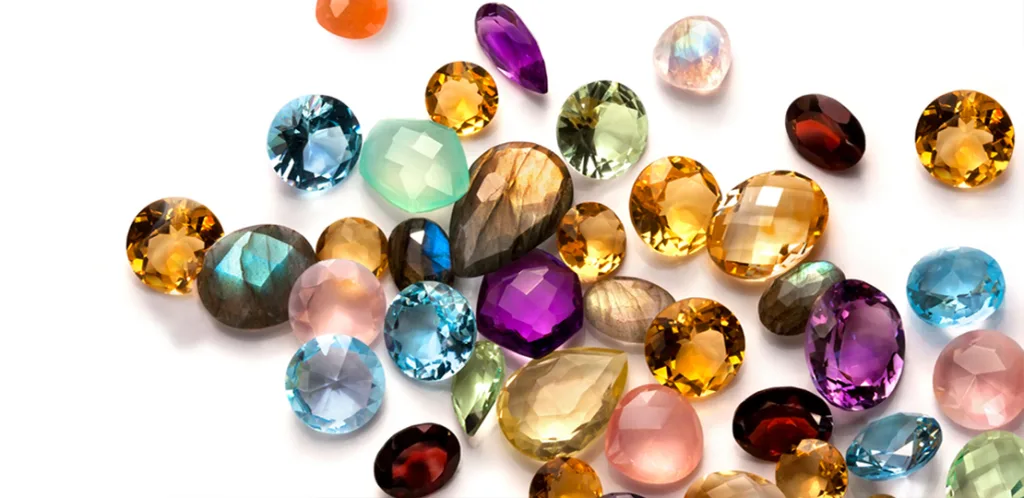
Precious and semi-precious coloured gemstones have graced royal heads to fashionista necklines. They have symbolized status, power, love, and beauty. Coloured gemstones, like diamonds, are also graded by gemmologists based on their characteristics or properties. This basic gemstone grading helps lay the foundation to command special attention and higher pricing for the gemstone. The 5Cs of coloured gemstonesLike diamonds, colour stones also have 5Cs or five characteristics. They are: – 1. ColourColour is the main characteristic of any gemstone. As coloured gemstones are varied and difficult to understand, gemmologists worldwide use standard parameters to grade the colour of the gemstone. Every gemstone colour is evaluated on the basis of three components. These are:- – HueHue is the color reflected by the gemstone and visible to the naked eye. The Gemological Institute of America (GIA) has categorized hues – red (R), orange (O), yellow (Y), green (G), blue (B), violet (V), and purple (P). Almost every primary color of the gemstone falls within one of these hue categories.– ToneTone describes the depth of the color as too light, light, medium, dark, or too dark. The Gemological Institute of America (GIA) assigns a number in the color gem grading code to represent the tone of the gem from light to dark when viewed from the top/table of the gemstone. The value ranges from 0, colorless or white, to 10, black. The tone of the gemstone continues to give it brilliance even when viewed away from direct light.– SaturationSaturation refers to the intensity of the gem’s hue ranging from light to strong and deep to shallow. At GIA, the saturation values range from 1 to 6. Warm hues, such as red, orange, and yellow, become shades of brown as their saturation decreases. Cool hues, like blue and violet, become progressively more gray as their saturation decreases. 2. ClarityClarity is the second most crucial factor when comparing high-quality colored gemstones. It is simply described as – the relative absence of inclusions (materials trapped inside the gem), fractures, and blemishes (surface imperfections) that affect the appearance and structural integrity of a coloured gemstone. Since almost all mined gemstones contain inclusions, it is the size, position, and visibility of the inclusions that impact the overall quality of the stone. GIA has the following clarity grades: –– VVS: very, very small inclusions– VS: very small inclusions– SI1 and SI2: small inclusions– I1, I2, and I3: included– Dcl (déclassé) for cabochons, beads, or carvings.As a general rule, the lesser the inclusions or higher clarity, the better the value of the coloured stone. 3. CutCut plays an important part in determining the value of a faceted gem. The ideal cut enhances the colour, diminishes its inclusions, provides overall symmetry, and/or highlights certain characteristics of the gemstone. There are different cuts in coloured gemstones from round brilliant to hearts, pears, marquise, and more. The main elements that impact these cuts are: –– The outline or symmetry of the stone.– An optimum table.– Alignment of the crown and the pavilion– Shoulders and culet or keel lines.– Girdle thickness and unevenness.It is finally the cut and the polish that determine the overall look and feel of the gemstone. 4. CaratA carat is the standard unit for measuring gem weight. One carat equals 1/5 of a gram or 200 milligrams. As the carat weight corresponds to the density of the gemstone, sometimes two gemstones with the same weight may be very different in size. For example, a one-carat amethyst that has a specific gravity of 2.66 may look bigger than a sapphire with 4.00 specific gravity in the same weight. Thus, buying a coloured gemstone on the basis of carat weight may not make perfect sense. Besides carat weights, coloured gemstones are also set up for millimeter sizes. 5. CostThe price of a colored gemstone may vary from as little as INR 500 per carat to INR 5,00,000 per carat depending upon the gemstones colour, cut, clarity, and carat. But the price is also determined by another factor that is – rarity. Rarity is one of the most decisive factors that determine the cost or pricing of the gemstone. With natural deposits quickly depleting and few mines even closed down it makes the coloured stones from those mines more valuable and sought after. Tanzanites, Burma rubies, Alexandrites, Paraíba Tourmalines, Red Berlyls, and Benitoite are few coloured gems that are difficult to find and very costly too. ConclusionHaving said all of the above, it is equally necessary to know coloured gemstones are often treated to produce intense or light color and/or to improve the overall look and desirability of the gemstone. Emeralds are commonly oiled, sapphires heated, blue topaz and tourmalines irradiated, corals bleached, black onyx dyed, and lapis lazuli impregnated with colorless wax or oil. Thus, before buying a coloured gemstone, consider the treatment and the 5Cs or five characteristics – color, clarity, cut, carat, and cost before investing in the best gemstones for everyday wear or a collectors stone. Visit us at Online Courses to know more.
Know Your Diamond’s Weight, Measurement & Size

When you know a few basics about diamonds you can confidently pick your diamond jewellery, from the best engagement ring to a diamond eternity band. Often people are unaware of the 4Cs and the basic difference between diamond weight, measurement and size. It is these factors that work together to maximize the beauty and value of a diamond. So, today let’s understand the meaning of the carat and the cut. Understanding diamond weight A carat is a globally recognized standard for the weight of a diamond. In the 4C’s of diamonds – Cut, Colour, Clarity and Carat – carat refers to diamond weight, not its physical size. It is one of the main aspects that influences the price of a diamond. However, two diamonds of equal weight can be unequal in value, depending upon the other 3 specifications i.e. Cut, Colour and Clarity. How did the carat system start?For centuries gem traders used carob seeds to measure jewellery because they believed that there was minimum variance in the distribution of their mass. They used these small and uniform seeds as counterweights in their balance scales to mostly weigh gold. In the 1570s, jewellery traders began to use carob seeds to weigh diamonds as well. Slowly this practice grew, and each country began to adopt its own carat system, but there was no uniformity.In 1907, at the Fourth General Conference on Weights, the modern metric carat was adopted. It was introduced in the USA in 1913, and later spread to other countries as a standard measure for diamonds and other gemstones. Today, in the jewellery trade worldwide, a one carat (1 ct) diamond is equal to 200 milligrams or 0.2 grams. This is a universal measure for gemstones. How carat weight influences diamond valueWhen you divide the price of a diamond by its carats, it gives you its price per carat. The larger the diamond, the more expensive is the per carat weight. In natural large size diamonds, that are rarer than smaller-sized diamonds, as the carat weight increases, the value of the diamond also increases. However, the rise in value is not proportionate to the increase in the size of the diamond. It simply means the diamond prices increase exponentially as carat weight increases.There is also the magic weight that influences the price of diamonds. At a magic weight, the price of a diamond generally shoots up. Therefore, if you are planning to buy a one-carat solitaire engagement ring, it may be a good idea to compare the price with a 0.96ct diamond. There will be a significant price difference between the two stones but a negligible difference in the overall size. The reason is that the one carat (1 ct) size is a magic weight that greatly increases the price of the diamond.Diamonds are weighed very precisely to the nearest 0.01ct. In the diamond trade, another term associated with diamond weight is pointers. A diamond below one carat weight is measured by points, where one carat is equal to 100 ‘points.’ A one-pointer refers to a 0.01 carat diamond. A 50 pointer or half-carat diamond refers to a 0.50 carat stone. On the other hand, a diamond above one carat weight, is described in carats and decimals, e.g. a 2.15cts stone would be described as ‘two point fifteen carats.’Besides the carat weight as described above, the cut, colour and clarity of a diamond also influences the final pricing of the diamond. Magic sizesSome carat weights are considered critical weights or magic sizes. That means if a diamond weighs at any of these critical weights, the price shoots up exponentially, not in a linear fashion. These magic sizes are 0.25ct, 0.50ct, 0.75ct, 1.00ct, 1.50ct, 2.00ct, 3.00ct, 4.00ct, 5.00ct and 10.00ct.For diamonds with equal parameters in the other 3 Cs, the diamond value increases with carat weight mainly because of its popularity and global demand. If you can stay away from the magic sizes when buying diamonds, you can save upwards of 20% and there is no vast visual difference.Diamonds that are not of these magic sizes are called off-size diamonds. What is diamond measurement?The cut is another equally important 4C. When a diamond is in the right proportions it emits maximum brilliance and sparkle. The diamond measurement is basically its size. It includes the shape, cut and the length-to width ratio of the gemstone. The size of a diamond is measured in millimetres (mm). The size denotes how large the diamond will appear when viewed from the top or from its table.Standard diamond measurements roughly coincide with the carat weights. A 1-carat round diamond is typically 6.5 mm, while a 1.25-carat round diamond is 6.8 mm. Each diamond cut has a range of ideal length to width ratios depending on its shape. Here are some of the diamond shapes and their most proportional ranges that qualify as a good cut: Round: length to width ratio of 1.0 – 1.05 Princess: length to width ratio of 1.0 – 1.04 Cushion: length to width ratio of 1.0 – 1.08 Emerald: length to width ratio of 1.3 – 1.4 Oval: length to width ratio of 1.25 – 1.5 Pear: length to width ratio of 1.45 – 1.75 Marquise: length to width ratio of 1.85 – 2.0 The size of the diamondBoth the cut and the carat affect the size of a diamond.As we have observed, a proper balance of carat weight and proportions in a diamond is achieved by finding the right size that will yield the best price for the stone. Thus, the diamond size refers to the height and width of the diamond, as well as the measurements of some of its key parts like girdle thickness. It determines the size and quality of the diamond cut. However, two stones of the same diameter or depth can still have different carat weights and vice versa.Finally, the design element and the setting of the diamond will accentuate the size of the diamond.In conclusion, now that we know the difference in carat,



